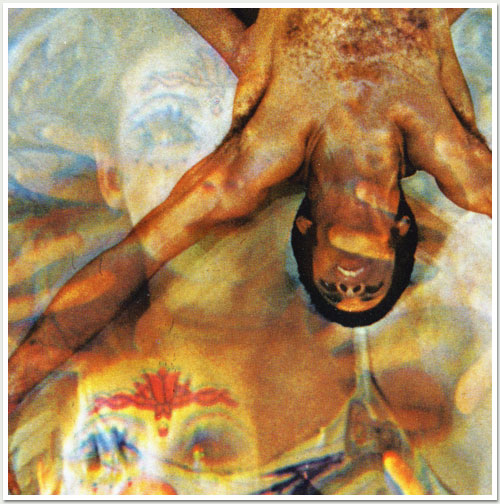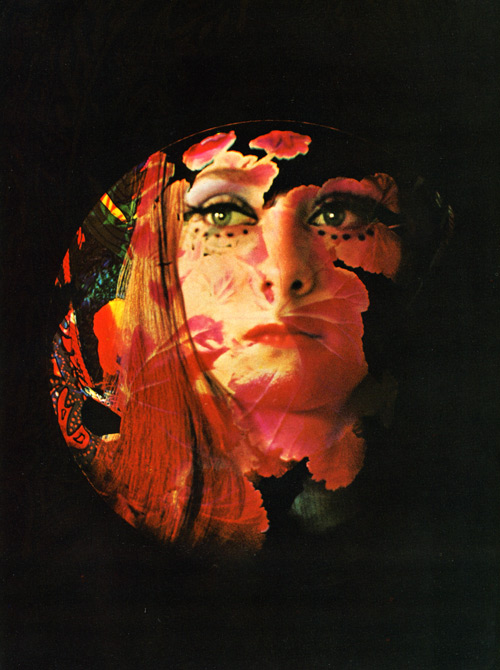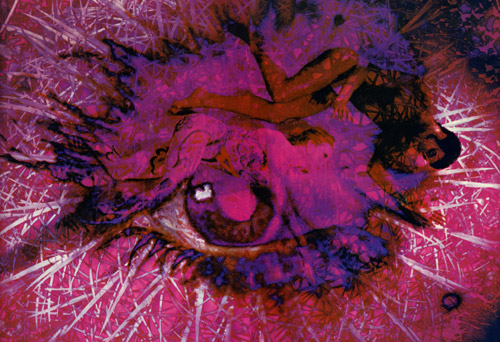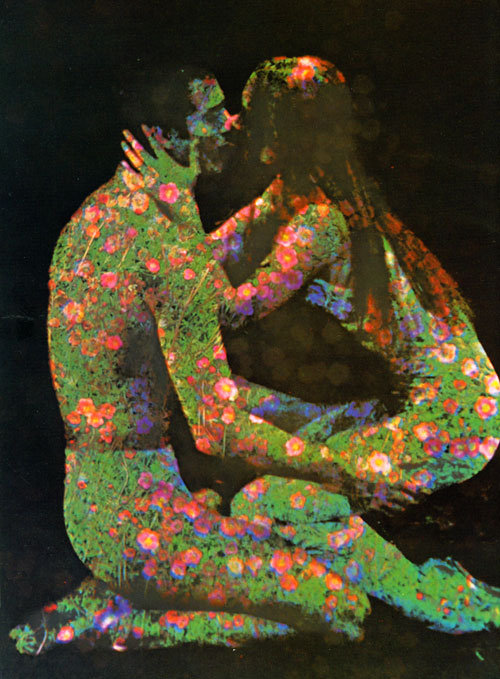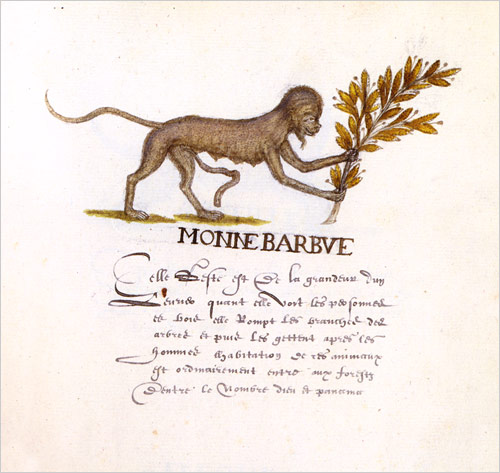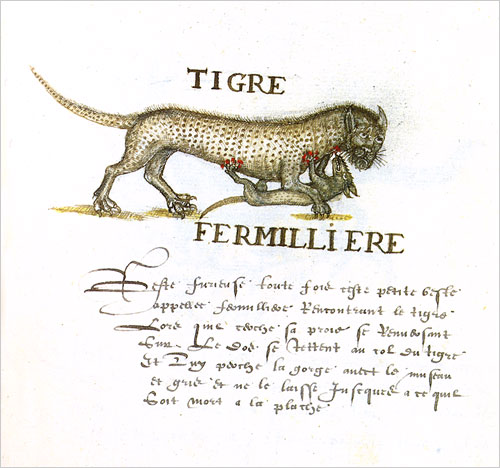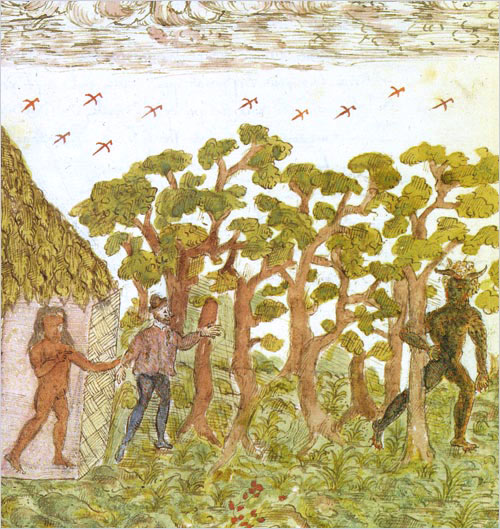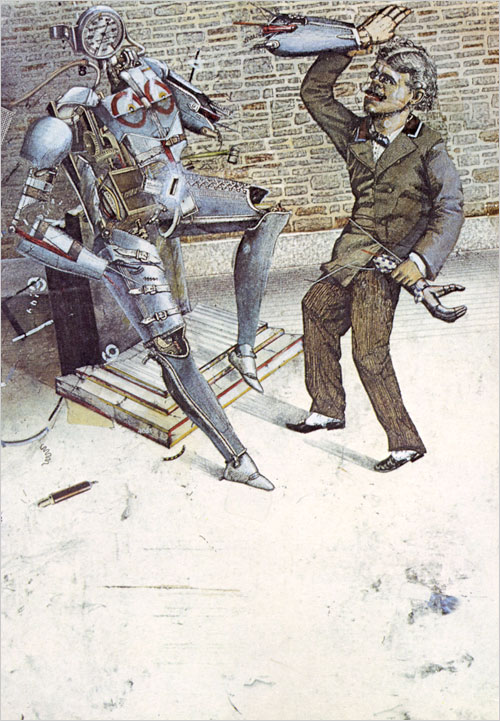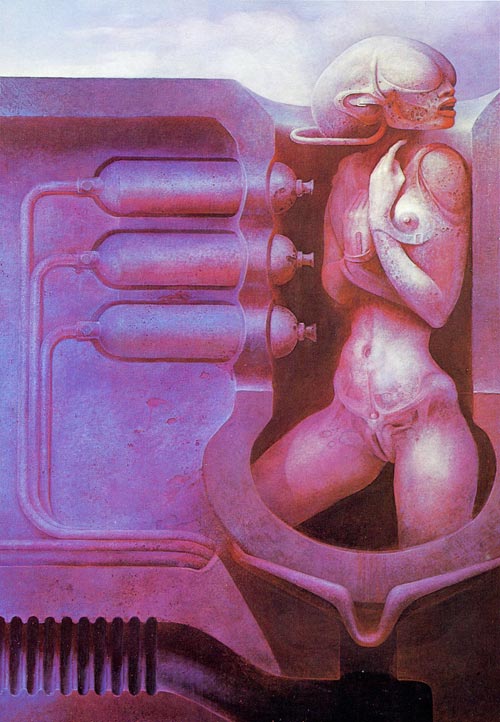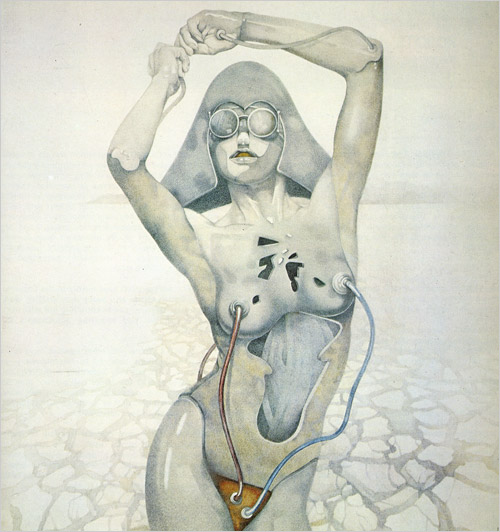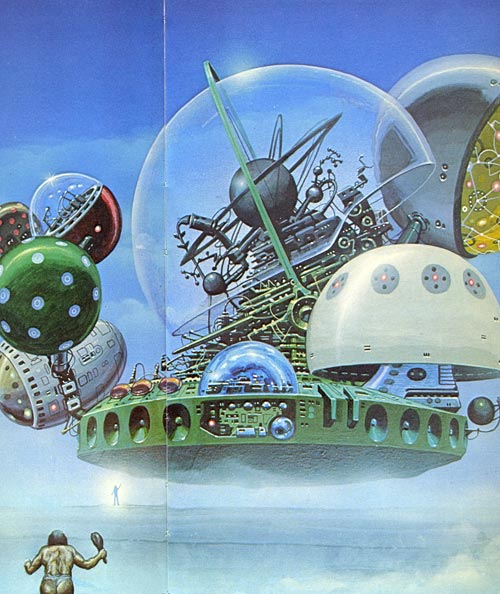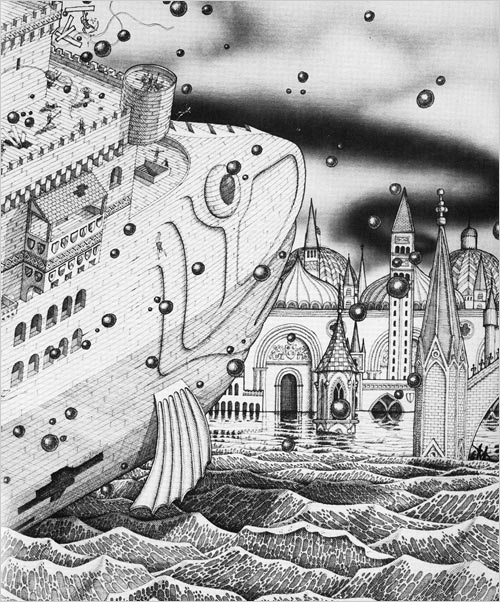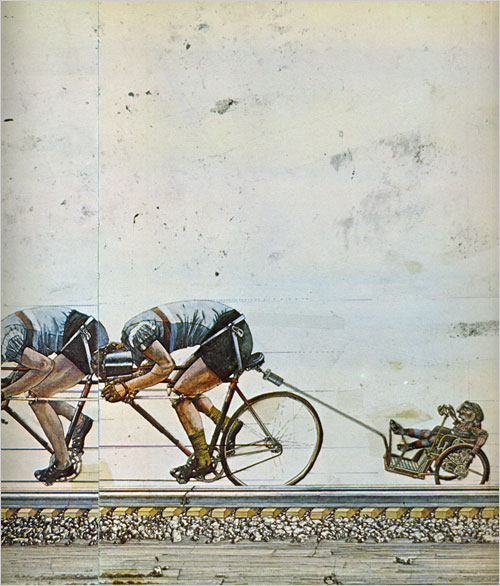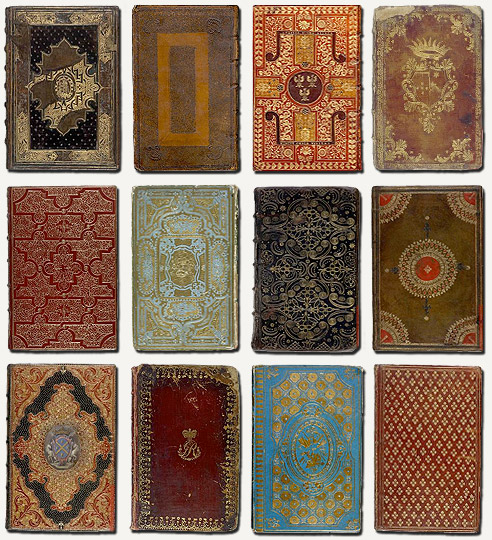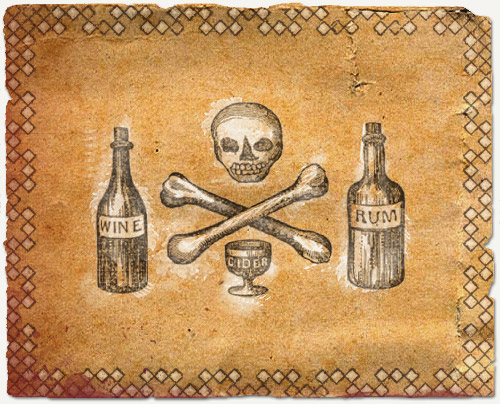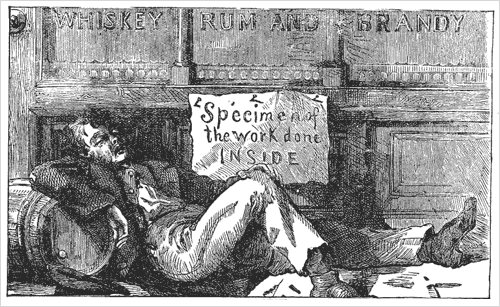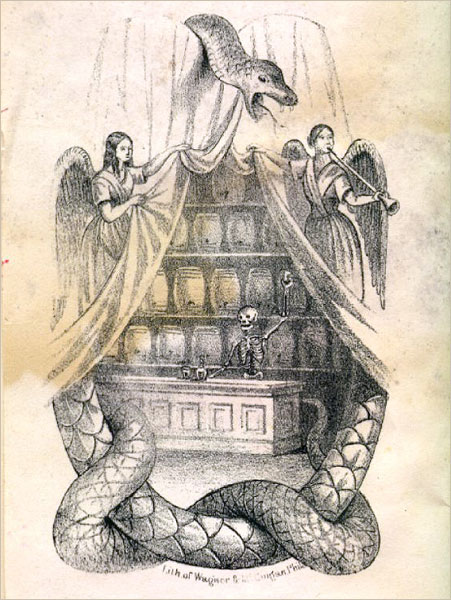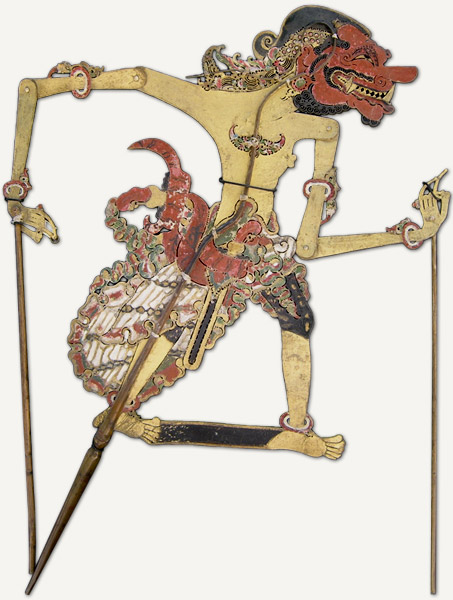Before the combination of Photoshop and, this vast repository of source-materials, the internet began spawning what now certainly amount to billions of wry photo-mashups, there was a predecessor which required of its practitioners expert hand-skills and vision and resourcefulness. I’m talking, of course, about collage, and in the days before pixels, indeed before periodicals positively overflowed with photographic imagery, a fellow, without formal training, by the name of Max Ernst took the form to places previously unimagined.
Around 1919, after having studied philosophy at the University of Bonn and serving in the German army on both the Western and Eastern fronts, Ernst began experimenting with collage. He explains the impetus as follows:
“One day (in 1919), whereas I looked at an illustrated book of objects (umbrellas, watches, tools, clothing, etc) I was surprised to see such different things tight beside the others, things which one does not see together usually, my eyes saw other objects, I wanted to add with the pencil some lines and hatchings between the various objects so that it gives the same images that I see in my dreams.” –Max Ernst.
“It was enough at that time to embellish these catalogue pages, in painting or drawing, and thereby in gently reproducing only that which saw itself in me, a colour, a pencil mark, a landscape foreign to the represented objects, the desert, a tempest, a geological cross-section, a floor, a single straight line signifying the horizon ... thus I obtained a faithful fixed image of my hallucination and transformed into revealing dramas my most secret desires—from what had been before only some banal pages of advertising.” —Max Ernst: Beyond Painting 1948.
The collage-novels which Ernst began creating in 1929, including La Femme 100 têtes (The Hundred Headless Women) and Une Semaine de bonté (A Week of Kindness), undoubtedly represent a pinnacle of the form.
I’d like to share with you some examples from a third collage novel by Ernst, published in 1930, titled, Rêve d’une petite fille qui voulut entrer au Carmel or, A Little Girl Dreams of Taking the Veil, which I am lucky enough to own a copy of. It is the story of a girl who loses her viginity on the day of her first communion and so commits herself to “taking the veil.” The collages, each accompanied by a few short lines, are visualizations of the impious, schizophrenic, and mostly nightmarish dreams she has that night.
The book begins with a 5 page surrealistic sketch by way of introduction. Here is an excerpt:
Academy of Science.
The night will come when the Academy of Science itself will not disdain to cast its gaze on the sewers of the world. The night will come when, covered with all their jewels, the secondary skeletons that one calls scientists will ask themselves this question:
?What do little girls dream of who want to take the veil?
?On that night a violent storm will break against the doors of the academy of science and the water will roar in the pipes.
?The water will remember the shameful year 1930, the year it would have liked to see all the cathedrals of the universe parade in far-too-short dresses. It will remember above all a certain night because…
?On Good Friday night of the shameful year 1930 a child hardly sixteen years old dipperd her two hands in the sewer, pricked her skin and with her blood traced these lines”
?To love the holy father and to dip one’s hands in a sewer, such is happiness for us, children of Mary.
77 collages follow, separated into four sections. Below I’ve reproduced 15 of them complete with accompanying text. Have a look.















The book’s translator’s note has this to say on the collages themselves:
“Each one of these collages uses cuttings often from the most banal of pre-photography illustrated penny novels, and from popular tomes about nature, science, and exoticism. The result may seem to embody our most frequent tragedies, our wriest enslavements, our most terrible solutions. Specificity dissolves in the timeless and the general.” —Dorothea Tanning.
The introduction to Max Ernst: A Retrospective adds the following:
“Max Ernst’s collages, for all their strangeness, strive for overall coherence and technical plausibility. This ‘plausible’ imagery, unlike the papiers colles of Picasso and Georges Braque, depends on an expurgation of the visible difference between artist’s hand and non-artistic quotation. The joins and overlappings had to be concealed from the viewer. This is why Ernst frequently published his composite imagery only in printed form, in photographic reproduction or in versions later touched up with watercolour. Thanks to these tactics of concealment he succeeded in presenting collage as that which he thought it should be: a completely developed and autonomous system in which the origin of the separate elements is submerged in the final, total image. He was out to produce irritating imagery in which, as in the perfect crime, every clue to its identity had been erased.” — Werner Spies.
To me there is a gravitas to etchings and wood engravings, a sort of official-ness, which is unshakeable. Perhaps it is simply the obvious effort involved in their creation or their historic connection with inherently valuable printed matter (be it newspaper or book) which lends the form these overtones. In any case, I think it is exactly this implied gravitas playing against Ernst’s strange, poetic, feverish, and funny subject matter, which creates the oddly arresting magnetism they still manage to exert almost 80 years later. I can only wonder at the effect they had on viewers in the 30’s… Some mixture of giggle and shiver I would imagine.
Anyhow, hope you enjoyed these.
For more on Ernst’s collage-novels see:
Une Semaine de Bonté: A Surrealistic Novel in Collage on google books.
Une Semaine de Bonté at La Boîte A Images.
A Week of Kindness at Giornale Nuovo.
La femme 100 têtes at Koninklijke Bibliotheek.
Werner Spies’ piece at Artchive.com.
The enduring significance of the work of Max Ernst By Stuart Nolan.
Max Ernst’s Adventures in Collage from The New York Times.
Kindness Week a film by Ernst based on his collage.
Ernst related videos at Tiosam.com
-
Note: This post is in a series of reworkings of old posts which date from before the redesign of The Nonist. The text has been reworked and added to considerably, the amount of images has been doubled, and the links are all new. I will be periodically adding these reworkings into the flow of new content in an effort to eventually remove all the old pages from circulation.
hide full text

